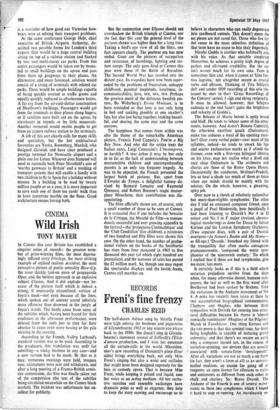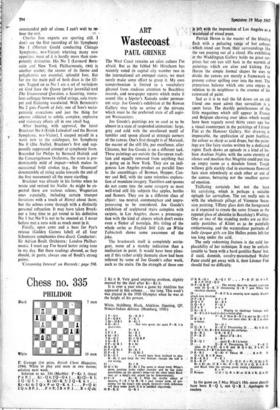Freni's fine frenzy
RECORDS CHARLES REID
The half-dozen Adinas sung by Mirella Freni were high among the bonbons and piquancies of Glyndebourne 1963 or any season you please back to the 1930s. She doesn't sing in Glynde- bourne's imminent revival of Zeffirelli's l'Elisir d'amore production, and I wish her successor all the curtain-calls in the world. Meantime, HMV's new recording of Donizetti's piece (four sides) brings everything back, not only Miss Freni's singing but also a waist and oeillades that might have been designed expressly for the best in comedy opera. That is because Miss Freni, while keeping it poised and liquid, uses her voice as an acting medium. All her recita- tive snatches and ensemble exchanges have dramatic point as well as elegance; they help to keep the story moving and encourage us to believe in characters who can easily degenerate into cardboard cutouts. This doesn't mean the set pieces are not cared for. Those who live for bel canto in the most relentless definition of that term have no cause to bite their fingernails.
Nicolai Gedda is another who habitually acts with his voice. As that amiable simpleton Nemorino, he achieves a pretty high degree of pathos and all-round credibility. But the ear isn't wooed much for its own sake. Tone is sometimes thin and. when it comes to 'Una fur- tiva lagrima,' not altogether secure at crucial turns and phrases. Thinking of Tito Schipa's deft and tender 1929 recording of this aria (re- issued by HMV in their 'Great Recordings of the Century' series), I sigh and shrug resignedly. It must be allowed, however, that Schipa's cadenza at the end hasn't quite the brightness and velocity of Gedda's.
The Belcore of Mario Sereni is aptly broad and bluff. He tends to labour some of his orna- ments, however. And doesn't Renato Capecchi, the otherwise excellent quack (Dulcamare), make too arduous a meal of his opening num- ber? Over every verbal point—over most of his syllables, indeed—he tends to smack his lips and scatter exclamation marks as if afraid the listener, even with a first-rate bilingual libretto on his knee, may not realise what a droll and racy chap Dulcamare is. The orchestra and chorus are those of the Rome Opera House. Occasionally the conductor, Molinari-Pradelli, lets us hear a shade too much of them at times when our minds should be mainly with the soloists. On the whole, however, a gleaming, spicy job.
Over now to a clutch of relatively unfamiliar but more-than-eligible symphonies. The other day I told an esteemed composer friend, once a pupil of Paul Hindemith, how beatifically I had been listening to Dvorak's No 4 in D minor and No 5 in F major (revised, chrono- logical numbering) as done for Decca by Istvan Kertesz and the London Symphony Orchestra. (Two separate discs, with a pair of Dvorak overtures—In Nature's Realm and My Home— as fill-ups.) 'Dvorak,' breathed my friend with the tranquillity that often marks outrageous pronouncements, 'composed the worst sym- phonies of the nineteenth century.' To which I replied that if these are bad symphonies, give me more; lots more.
It certainly looks as if this is a field where sectarian prejudices survive from the days when, for many otherwise decent, humane rate- payers, the last as well as the first word after Beethoven had been spoken by Brahms. Take the variations in the Andante movement of No 4. A poke has recently been taken at these by two accomplished biographical commentators, Clapham and Hughes, who between them sympathise with Dvorak for running into struc- tural difficulties because his theme is 'almost comically reminiscent' (Hughes) of the Pilgrims' March in Tannhauser. One thing Kertesz and the LSO prove is that this seminal tune, far from being laughable, is capable of inducing grand solemnity; and that there's no reason on earth why a composer should not, in the course of variation-spinning. use devices that are usually associated with sonata-form 'development.' After all, variations are not so much a set form (in fact, they aren't a form at all) as an untram- melled medium; an excuse for going off at tangents; an open licence for allusions to styles and sentiments as different from each other as chalk and chutney. So: Bravo Dvorak. The Andante of the Fourth is one of several move- ments in these two symphonies which I found it hard to stop re-running. An inordinately re- commended pair of sirens. I can't wait to re- hear the rest.
Charles Ives exports are spurting still. I don't see the first recording of his Symphony No 1 (Morton Gould conducting Chicago Symphony, RCA-Victor) whetting many new appetites; most of it is hardly more than com- petently derivative. His No 2 (Leonard Bern- stein and New York Philharmonic, cas) is another matter; the savour of its theme and polyphonies are essential, splendid Ives. But for me the main pull of both discs is the fill- ups. Tagged on to No I are a set of variations on God Save the Queen (perky juvenilia) and The Unanswered Question, a haunting, tremu- lous colloquy between veiled strings, solo trum- pet and flickering woodwind. With Bernstein's No 2 goes Fourth of July, one of Ives's socio- patriotic evocations and just the thing for anyone addicted to subtle, complex, explosive and visionary effects all in one small bag.
After hearing, with approval, the latest Bruckner No 4 (Erich Leinsdorf and the Boston Symphony, RCA-Victor), I steeped myself in a work new to the catalogues, his Symphony No 0 (Die Nulite), Bruckner's first and sup- posedly suppressed attempt at symphonic form. Recorded for Philips by Bernard Haitink and the Concertgebouw Orchestra, the score is pre- dominantly mild of impact—which makes its occasional bold strokes (e.g., the 'dissonant' downtumble of string scales towards the end of the first movement) all the more startling.
Bruckner was already in his forties when he wrote and revised his NuIlte. As might be ex- pected there are various echoes, Wagnerian ones especially, including certain trumpet iterations with a touch of Rienzi about them; but the echoes come through with a distinctly personal refraction. It may have taken Bruck- ner a long time to get round to his definitive No 1 but No 0 is not to be sneezed at. I never before met a zero with as much meat in it.
Finally, open arms and a buss for Pye's reissue (Golden Guinea label) of all four Schumann symphonies (two discs). Conductor : Sir Adrian Boult. Orchestra: London Philhar- monic. I must say I've heard better string tone in my day. But these readings abound, as they should, in gusto, always one of Boult's strong points.
'Consuming Interest' on Records: page 596.



































 Previous page
Previous page